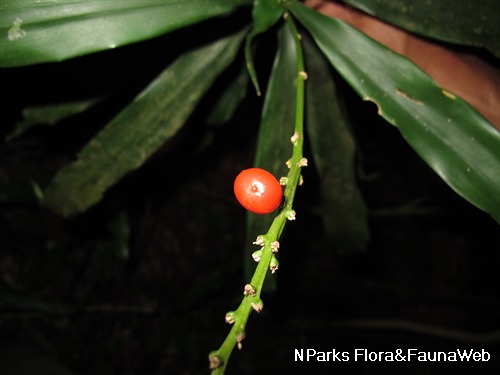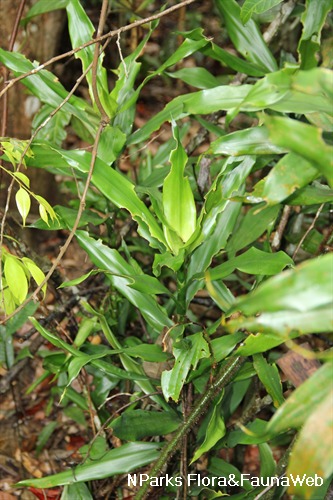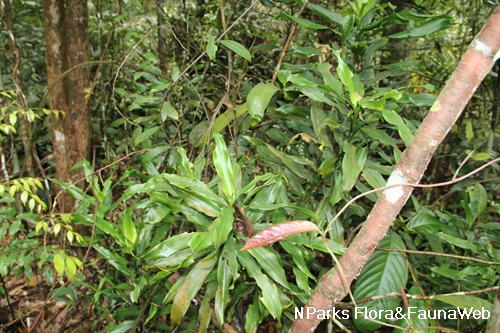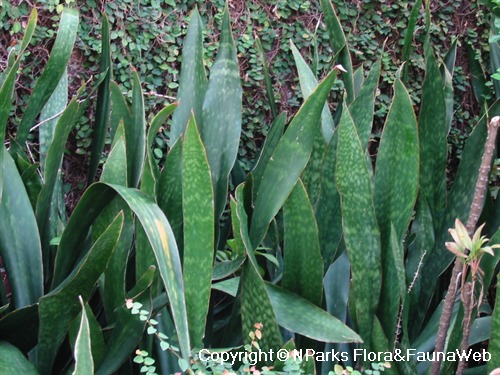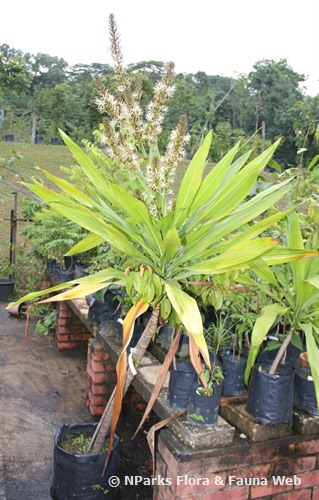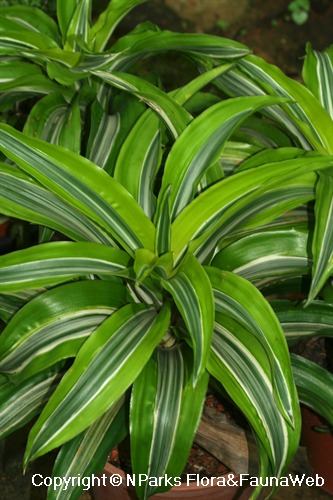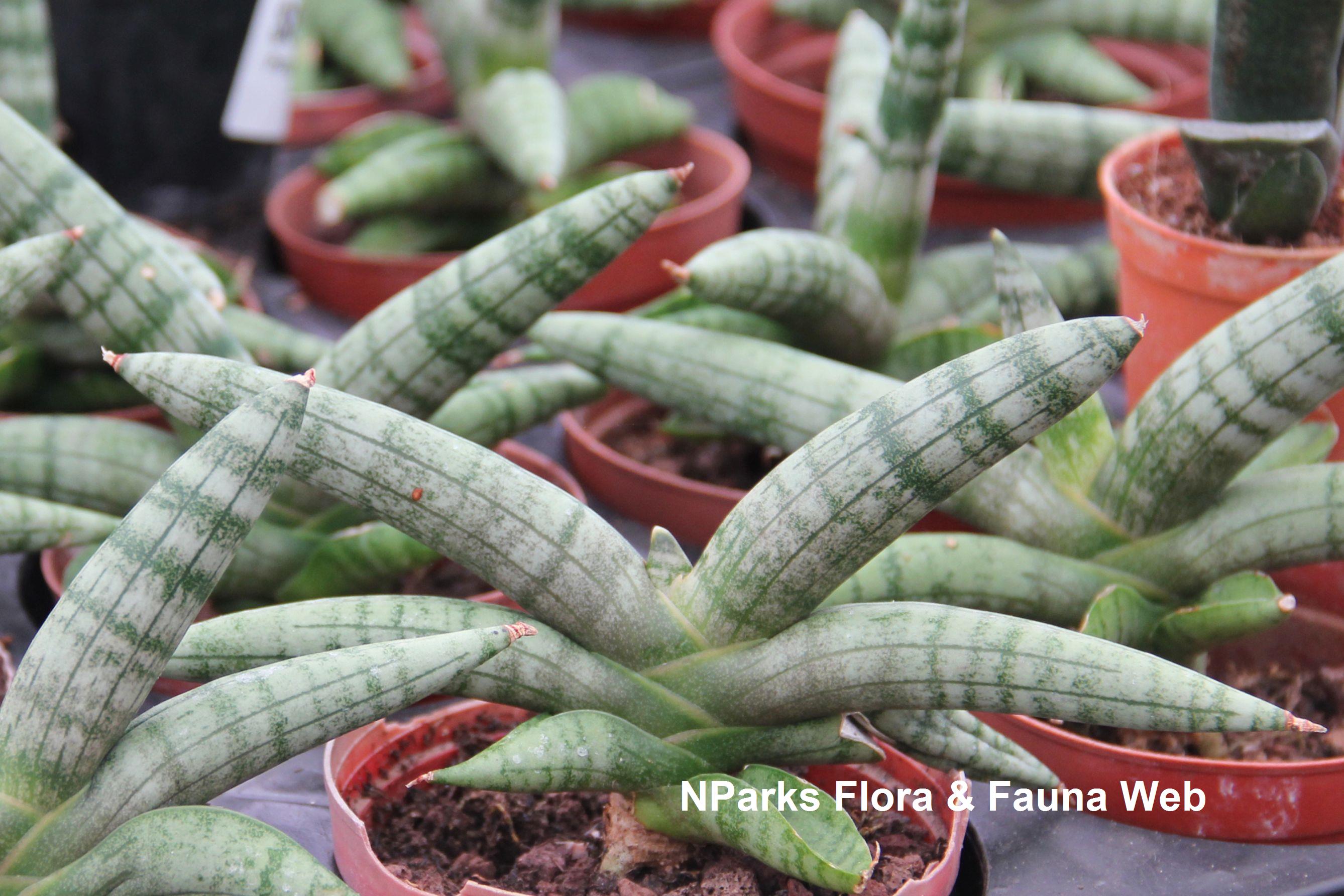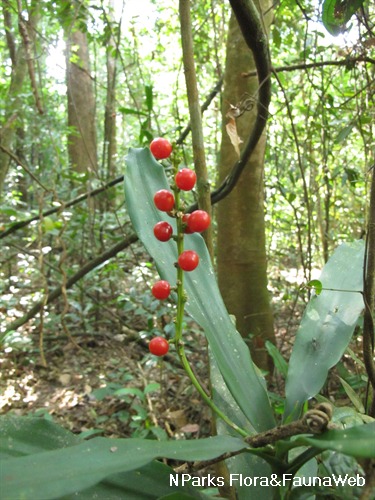
Back
Dracaena porteri Baker
| Family Name: | Asparagaceae |
| Synonyms: | Pleomele porteri (Baker) N.E.Br. |
| Common Name: | Jarum-jarum |
Name
Classifications and Characteristics
| Plant Division | Angiosperms (Flowering Seed Plants) (Monocotyledon) |
|---|---|
| Plant Growth Form | Shrub |
| Lifespan (in Singapore) | Perennial |
| Mode of Nutrition | Autotrophic |
| Plant Shape | Irregular |
| Maximum Height | 1.5 m |
Biogeography
| Native Distribution | Thailand, Peninsular Malaysia, and Singapore |
|---|---|
| Native Habitat | Terrestrial (Primary Rainforest, Secondary Rainforest, Freshwater Swamp Forest) |
| Preferred Climate Zone | Tropical |
| Local Conservation Status | Native to Singapore (Least Concern (LC)) |
Description and Ethnobotany
| Growth Form | It is a short, little branched shrub, 0.6 - 1.5 m tall. |
|---|---|
| Foliage | Its spirally arranged, unstalked, leaves have leathery leaf blades that are usually linear-lance-shaped with pointed tip and narrowed base, green, and 15–38 by 1–4 cm. |
| Flowers | Its white flowers are 2 cm long, and occur in loose clusters of 2–3 on a branched inflorescence. |
| Fruit | Its fruits are round, red, and about 1 cm in diameter. |
| Habitat | It grows in lowland forests, often in wet areas. It occurs locally in Pulau Tekong, the Central Catchment Nature Reserve (including MacRitchie Reservoir, Lower Pierce Reservoir, and Nee Soon Swamp Forest), along Chestnut Avenue, and Bukit Timah Nature Reserve. |
| Associated Fauna | Its flowers are insect-pollinated while its fruits and seeds are probably eaten and dispersed by birds or mammals. |
| Cultivation | It may be suitable for parks. It can be propagated by seed and stem cuttings. |
| Etymology | Greek dracaena, a dragon, referring to the bright red dried red resin, called dragon’s blood, obtained from various species including those of Dracaena; Latin porteri, commemorating Charles Porter, a botanical collector. |
Landscaping Features
| Landscaping | It may be suitable for parks. |
|---|---|
| Desirable Plant Features | Ornamental Foliage |
| Landscape Uses | General, Parks & Gardens, Small Gardens |
Fauna, Pollination and Dispersal
| Pollination Method(s) | Biotic (Fauna) |
|---|---|
| Seed or Spore Dispersal | Biotic (Fauna) |
Plant Care and Propagation
| Light Preference | Semi-Shade, Full Shade |
|---|---|
| Water Preference | Moderate Water |
| Rootzone Tolerance | Moist Soils |
| Propagation Method | Seed, Stem Cutting (Semi-Hardwood) |
Foliar
| Foliage Retention | Evergreen |
|---|---|
| Mature Foliage Colour(s) | Green |
| Mature Foliage Texture(s) | Leathery |
| Foliar Type | Simple / Unifoliate |
| Foliar Arrangement Along Stem | Alternate |
| Foliar Attachment to Stem | Sessile |
| Foliar Shape(s) | Non-Palm Foliage (Lanceolate, Linear) |
| Foliar Venation | Parallel |
| Foliar Margin | Entire |
| Foliar Apex - Tip | Acute, Acuminate |
| Foliar Base | Attenuate |
Floral (Angiosperm)
| Flower Colour(s) | White |
|---|---|
| Flower Grouping | Cluster / Inflorescence |
| Flower Location | Terminal |
| Inflorescence Type | Panicle |
Fruit, Seed and Spore
| Mature Fruit Colour(s) | Red |
|---|---|
| Fruit Classification | Simple Fruit |
| Fruit Type | Fleshy Fruit , Non-Accessory Fruit |
Image Repository
Others
| Master ID | 31029 |
|---|---|
| Species ID | 5416 |
| Flora Disclaimer | The information in this website has been compiled from reliable sources, such as reference works on medicinal plants. It is not a substitute for medical advice or treatment and NParks does not purport to provide any medical advice. Readers should always consult his/her physician before using or consuming a plant for medicinal purposes. |

